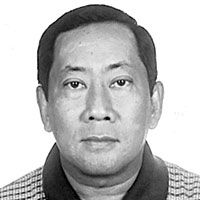Learning more about the Cebuano tongue

August 23, 2004 | 12:00am
Last Friday, the launching of the Program: Promoting Cebuano Language & Culture at the University of the Philippines Cebu College through the Central Visayas Studies Center was very well-attended. Unfortunately, I missed the morning sessions, especially the keynote address of UP president Dr. Francisco Nemenzo and that "Balak" by Prof. Alfredo Montano because I had to attend the first meeting of the Regional Development Council (RDC-7) at the Ecotech Center where newly appointed Tourism Secretary Joseph "Ace" Durano was introduced as the Cabinet Official for Regional Development (CORD).
But the afternoon sessions in UP proved to be quite interesting, especially the part done by Engr. Jes B. Tirol, Ph.D., chairman of the University of Bohol’s board of trustees, who gave us lessons in mathematics in Cebuano. Yes, I’ve been speaking in Cebuano all my life, but because of our language policies, I find it difficult to read in Cebuano… and it just occurred to me that there are so many words that I have been missing… thinking that most of the words I knew or use in Cebuano were Cebuano.
Engr. Tirol apparently dug up a old "Kapulongan" or dictionary in Cebuano by Fr. Matheo Sanchez (1618) and Fr. Juan de las Encarnacion (1885) where he found many old Cebuano words that have been lost through time. For instance, I didn’t know that the Cebuanos had a word for a million, which is "yukot," or a billion, which is "wakat." He also named all the fingers in our hands, and I could remember only "kumagko" and "kaming-king" which stand for the thumb and little finger… but there are Cebuano names for all the other fingers… like "singsingan" for the ring finger.
For many years, Cebuanos have been using Spanish in naming the days of the week, like Lunes, Martes, Mierkoles etc. Well, Engr. Tirol taught us that the week "Pitlaw" starts with Monday, "Tigburukad"; Tuesday, "Dumason"; Wednesday, "Dukot-dukot"; Thursday, "Baylo-baylo"; Friday, "Danghus"; Saturday, "Hingot-hingot"; and Sunday, "Ligid-ligid," which in Cebuano means to lay down as it is a day of rest.
There’s a lot more that we learned about the richness of the Cebuano language and culture. Prof. Raymund and Estela Fernandez also lectured us on the works of Cebuano artists Canuto Avila (I’m not sure if I’m related with this Avila) and Ray Francia whose works are similar to Michaelangelo’s in the Sistine Chapel as these two Cebuano artists painted the ceilings of many churches in Cebu and Bohol. Prof. Fernandez apparently photographed all these paintings in order to preserve them.
Indeed, it is quite rejuvenating to see young students taking a serious interest in their native language. More so when my good friend, Dr. Jose Dacudao, president of Save Our Languages Through Federalism (Solfed), and our national executive director, Fr. Joesilo Amalia, brought with them the Solfed choir to sing the National Anthem, not only in Cebuano, but in Butuanon and Ilonggo as well to the delight of the audience. What can I say, but thank you to the University of the Philippines, under Nemenzo, who like many of us in Cebu want to teach our children the Cebuano language and culture.
Still on the issue of language, I’m sure that by now, everyone knows that Sen. Lito Lapid is "handicapped" by his inability to speak English and thus, insists only in learning "Pilipino." Well, I got a text from my friend Lino Faelnar in Manila who said, "What is needed is a concerted effort to stop the media, the academe and government officials from misleading the Filipino people by passing off the Tagalog language as Pilipino. This is intellectual dishonesty and is not what the Constitution contemplates." I fully agree!
Perhaps another misinformation being peddled is that Cebuano or the other languages in the Philippines, like Chavacano, Ilocano, Waray or Ilonggo, are dialects of Pilipino. No sir, these are languages on their own. For instance, the dialect of Cebuano is the Boholano’s "ija-ija, ajo-ajo."
Quite timely, last Friday, Jerry Tundag, The Freeman editor, wrote in his column "To the Quick" entitled "Lapid needs to learn English." Jerry wrote, "The Philippine Constitution is very explicit in declaring that a national language has yet to evolve. Indeed, technically, such declaration makes the Linggo ng Wika law unconstitutional and thus illegal." Jerry adds, "Tagalog is not only the national language, it is also a dying language corrupted into a different form called Taglish largely by members of the showbiz industry where Lapid cut his teeth. Tagalog purists are in fact alarmed that almost no one nowadays can speak straight Tagalog. Taglish has become the lingua franca in the Tagalog-speaking provinces." How very observant of Jerry…and very true!
We’ve said it here before that Tagalog, as it was spoken by Balagtas, might just disappear ahead of Cebuano because of that Metro Manila-speak called Taglish, which many people find chic. At least in Cebu, we don’t mix (dili namo sagulon) Cebuano with English… it’s either we speak entirely in Cebuano or in English. Hence, we must all make an effort to preserve our languages. As I’ve said before, we have biblical or theological grounds for doing so, as God so willed it in Genesis, through the Tower of Babel and as the Old Testament is fulfilled in the New Testament, during Pentecost Sunday, they all spoke in "tongues." Now once and for all, why didn’t God ordain that everyone speak in one language or Latin, the lingua franca at that time?
Let me point out clearly that we’re not trying to promote a fight between Tagalogs and Cebuanos… far from it. We just want the ultra-nationalists to know and realize that many of us who cannot speak Tagalog love our country just as much as they do. More importantly, that if man can work hard to protect the endangered species like the sea turtle, the Philippine Eagle or the blue whale, there’s no reason why man shouldn’t preserve our diverse cultures and languages in this archipelago called the Philippines.
For e-mail responses to this article, write to [email protected]. Bobit Avila’s columns can also be accessed through www.thefreeman.com. He also hosts a weekly talk show, "Straight from the Sky," shown every Monday, at 8 p.m., only in Metro Cebu on Channel 15 of SkyCable.
But the afternoon sessions in UP proved to be quite interesting, especially the part done by Engr. Jes B. Tirol, Ph.D., chairman of the University of Bohol’s board of trustees, who gave us lessons in mathematics in Cebuano. Yes, I’ve been speaking in Cebuano all my life, but because of our language policies, I find it difficult to read in Cebuano… and it just occurred to me that there are so many words that I have been missing… thinking that most of the words I knew or use in Cebuano were Cebuano.
Engr. Tirol apparently dug up a old "Kapulongan" or dictionary in Cebuano by Fr. Matheo Sanchez (1618) and Fr. Juan de las Encarnacion (1885) where he found many old Cebuano words that have been lost through time. For instance, I didn’t know that the Cebuanos had a word for a million, which is "yukot," or a billion, which is "wakat." He also named all the fingers in our hands, and I could remember only "kumagko" and "kaming-king" which stand for the thumb and little finger… but there are Cebuano names for all the other fingers… like "singsingan" for the ring finger.
For many years, Cebuanos have been using Spanish in naming the days of the week, like Lunes, Martes, Mierkoles etc. Well, Engr. Tirol taught us that the week "Pitlaw" starts with Monday, "Tigburukad"; Tuesday, "Dumason"; Wednesday, "Dukot-dukot"; Thursday, "Baylo-baylo"; Friday, "Danghus"; Saturday, "Hingot-hingot"; and Sunday, "Ligid-ligid," which in Cebuano means to lay down as it is a day of rest.
There’s a lot more that we learned about the richness of the Cebuano language and culture. Prof. Raymund and Estela Fernandez also lectured us on the works of Cebuano artists Canuto Avila (I’m not sure if I’m related with this Avila) and Ray Francia whose works are similar to Michaelangelo’s in the Sistine Chapel as these two Cebuano artists painted the ceilings of many churches in Cebu and Bohol. Prof. Fernandez apparently photographed all these paintings in order to preserve them.
Indeed, it is quite rejuvenating to see young students taking a serious interest in their native language. More so when my good friend, Dr. Jose Dacudao, president of Save Our Languages Through Federalism (Solfed), and our national executive director, Fr. Joesilo Amalia, brought with them the Solfed choir to sing the National Anthem, not only in Cebuano, but in Butuanon and Ilonggo as well to the delight of the audience. What can I say, but thank you to the University of the Philippines, under Nemenzo, who like many of us in Cebu want to teach our children the Cebuano language and culture.
Perhaps another misinformation being peddled is that Cebuano or the other languages in the Philippines, like Chavacano, Ilocano, Waray or Ilonggo, are dialects of Pilipino. No sir, these are languages on their own. For instance, the dialect of Cebuano is the Boholano’s "ija-ija, ajo-ajo."
Quite timely, last Friday, Jerry Tundag, The Freeman editor, wrote in his column "To the Quick" entitled "Lapid needs to learn English." Jerry wrote, "The Philippine Constitution is very explicit in declaring that a national language has yet to evolve. Indeed, technically, such declaration makes the Linggo ng Wika law unconstitutional and thus illegal." Jerry adds, "Tagalog is not only the national language, it is also a dying language corrupted into a different form called Taglish largely by members of the showbiz industry where Lapid cut his teeth. Tagalog purists are in fact alarmed that almost no one nowadays can speak straight Tagalog. Taglish has become the lingua franca in the Tagalog-speaking provinces." How very observant of Jerry…and very true!
We’ve said it here before that Tagalog, as it was spoken by Balagtas, might just disappear ahead of Cebuano because of that Metro Manila-speak called Taglish, which many people find chic. At least in Cebu, we don’t mix (dili namo sagulon) Cebuano with English… it’s either we speak entirely in Cebuano or in English. Hence, we must all make an effort to preserve our languages. As I’ve said before, we have biblical or theological grounds for doing so, as God so willed it in Genesis, through the Tower of Babel and as the Old Testament is fulfilled in the New Testament, during Pentecost Sunday, they all spoke in "tongues." Now once and for all, why didn’t God ordain that everyone speak in one language or Latin, the lingua franca at that time?
Let me point out clearly that we’re not trying to promote a fight between Tagalogs and Cebuanos… far from it. We just want the ultra-nationalists to know and realize that many of us who cannot speak Tagalog love our country just as much as they do. More importantly, that if man can work hard to protect the endangered species like the sea turtle, the Philippine Eagle or the blue whale, there’s no reason why man shouldn’t preserve our diverse cultures and languages in this archipelago called the Philippines.
BrandSpace Articles
<
>
- Latest
- Trending
Trending
Latest
Trending
Latest
Recommended



























